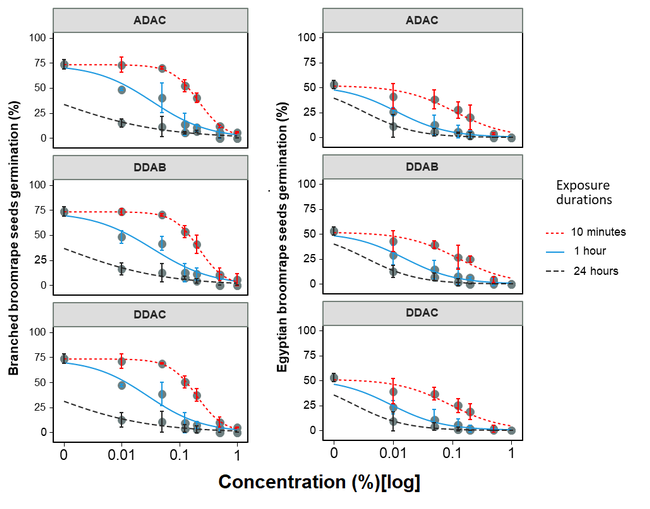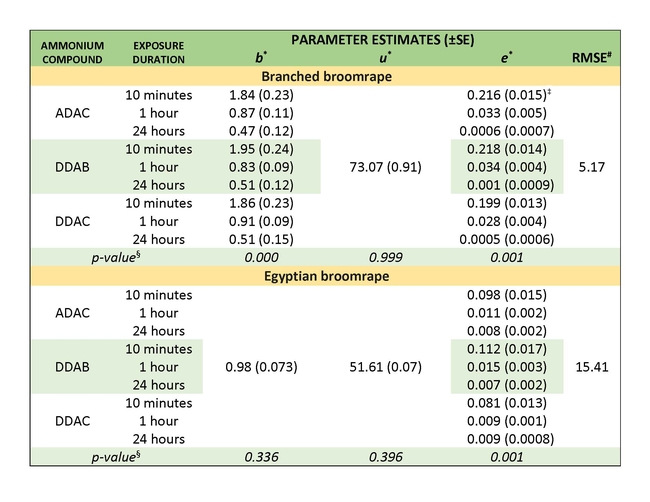California is the largest producer of processing tomato in the US (Winans et al. 2020). However, the profitability of the tomato industry in California is seriously threatened due to the presence of the parasitic weed branched and Egyptian broomrape (https://ucanr.edu/blogs/blogcore/postdetail.cfm?postnum=50241). These weeds can severely damage the host reducing the aerial biomass and leaf chlorophyll content (Mauromicale et al. 2008) with yield losses of up to 80% (Eizenberg and Goldwasser 2018).
Broomrape produces hundreds of thousands of tiny seeds (0.2 – 0.4 mm), which can be transported easily by humans, water, wind, and animals (Eizenberg et al. 2012; Ginman et al. 2015). Farm machinery (e.g. harvesters) is one of the most important ways of dispersal of broomrape seeds in tomato (Hershenhorn et al. 2009; Rubiales and Fernández-Aparicio 2012). Because of its highly mechanized cropping system, dispersal by farm machinery is particularly concerning in California. Movement of farm equipment between plots of the same farm or between farms is very common, which if contaminated, the equipment can facilitate both the short- and long-distance dispersal of broomrape seeds. Because there are currently limited methods to control this quarantine pests, reducing the spread to new fields is a very high priority for the tomato industry. Ideally, farming implements used in an infested field should be cleaned and sanitized before entering other fields or farms. The first step for equipment sanitation is physical removal of plant and soil residues. After debris is removed with compressed air and power washing, the next step involves using effective disinfecting chemicals to kill any broomrape seeds that might be left on the equipment (Osipitan et al. 2021). See attachment below for a current “Best Management Guidelines” developed by our research collaborators.
Quaternary ammonium compounds are surface-active chemicals that are widely used as sanitation solutions in the food processing industry, disinfectants, fabric softeners and cosmetics (Martínez-Carballo et al. 2007). We tested the efficacy of various quaternary ammonium compound's ability to prevent the germination of branched and Egyptian broomrape seeds with the goal of finding a material to disinfect farm machinery.
A three-parameter log-logistic model was used to characterize the seed germination responses of both branched and Egyptian broomrape to different sanitation doses across three exposure durations of 10 minutes, 1 hour, and 24 hours (Figure 1 and Table 1). All three chemical compounds (ADAC, DDAB, and DDAC) displayed a significant effect on seed germination of both broomrape species seeds, and complete prevention was achieved with the three tested exposure durations when these chemicals were applied at the maximum rate, i.e., 1% w/v. However, ED50 values of all disinfectants decreased with increased exposure duration in both broomrape species. In ADAC, for example, a concentration of 0.216% (w/v) was required to provide a 50% reduction in branched broomrape seed germination when seeds were exposed to this chemical for 10 minutes. In contrast, only 0.0006% (w/v) was enough to give the same level of reduction in seed germination when exposure duration increased to 24 hours. The same trend was observed with the two other products DDAB and DDAC, across both broomrape species. A comparison of ED50 values between the two broomrape species indicated that these ammonium compounds could halt germination in Egyptian broomrape seeds at lower concentrations compared to branched broomrape seeds suggesting greater sensitivity of Egyptian broomrape seeds to ammonium compounds (Table 1).
Sanitation of farm equipment before entering other farms can help reduce the introduction of broomrape seeds to non-infested fields. Quaternary ammonium compounds are widely used as disinfectants and have been found to be effective for broomrape seed eradication. Further research should be conducted to evaluate the efficacy of other sanitizer classes (e.g., peracetic acid, acid-anionic sanitizers, fatty acid sanitizers, biguanide, and peroxides), which are used in the food industry and have been found to be more effective than quaternary ammonium compounds in sterilizing surfaces (Bernardi et al. 2019). Furthermore, a shorter exposure time needs to be evaluated for equipment sanitation in further studies.
Because broomrape is a relatively new pest in the US, few sanitizer products specifically list broomrape on the label and this is, technically, and pesticidal use. Before using quaternary ammonium or any other sanitizing agent to aid in broomrape mitigation, please check with your local Agricultural Commissioner to verify that it is an acceptable use in your area.
We would like to thank the California Tomato Research Institute and the California Department of Food and Agriculture for funding this research.
From the Weed Technology 36(5): 723-728. DOI: https://doi.org/10.1017/wet.2022.74
Pershang Hosseini (perhosseini@ucdavis.edu) is a postdoctoral scholar in Brad Hanson's Lab at UC Davis.
Attached Files:

